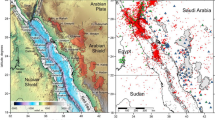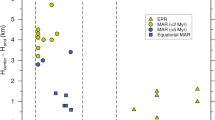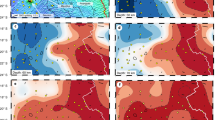Abstract
The origin of mid-ocean ridge segmentation—the systematic along-axis variation in tectonic and magmatic processes—remains controversial. It is commonly assumed that mantle flow is a passive response to plate divergence and that between transform faults magma supply controls segmentation. Using seismic tomography, we constrain the geometry of mantle flow and the distribution of mantle melt beneath the intermediate-spreading Endeavour segment of the Juan de Fuca Ridge. Our results, in combination with prior studies, establish a systematic skew between the mantle-divergence and plate-spreading directions. In all three cases studied, mantle divergence is advanced with respect to recent changes in the plate-spreading direction and the extent to which the flow field is advanced increases with decreasing spreading rate. Furthermore, seismic images show that large-offset, non-transform discontinuities are regions of enhanced mantle melt retention. We propose that oblique mantle flow beneath mid-ocean ridges is a driving force for the reorientation of spreading segments and the formation of ridge-axis discontinuities. The resulting tectonic discontinuities decrease the efficiency of upward melt transport, thus defining segment-scale variations in magmatic processes. We predict that across spreading rates mid-ocean ridge segmentation is controlled by evolving patterns in asthenospheric flow and the dynamics of lithospheric rifting.
This is a preview of subscription content, access via your institution
Access options
Subscribe to this journal
Receive 12 print issues and online access
$259.00 per year
only $21.58 per issue
Buy this article
- Purchase on Springer Link
- Instant access to full article PDF
Prices may be subject to local taxes which are calculated during checkout





Similar content being viewed by others
References
Schouten, H., Klitgord, K. D. & Whitehead, J. A. Segmentation of mid-ocean ridges. Nature 317, 225–229 (1985).
Macdonald, K. C. et al. A new view of the mid-ocean ridge from the behaviour of ridge-axis discontinuities. Nature 335, 217–225 (1988).
Sempéré, J. C., Purdy, G. M. & Schouten, H. Segmentation of the Mid-Atlantic Ridge between 24° N and 30° 40′ N. Nature 344, 427–431 (1990).
Langmuir, C. H., Bender, J. F. & Batiza, R. Petrological and tectonic segmentation of the East Pacific Rise, 5° 30′–14° 30′ N. Nature 322, 422–429 (1986).
Kent, G. M. et al. Evidence from three-dimensional seismic reflectivity images for enhanced melt supply beneath mid-ocean-ridge discontinuities. Nature 406, 614–618 (2000).
Carbotte, S. M., Smith, D. K., Cannat, M. & Klein, E. M. in Magmatic Rifting and Active Volcanism Vol. 420 (eds Wright, T. J., Ayele, A., Ferguson, D. J., Kidane, T. & Vye-Brown, C.) (The Geological Society of London, 2015).
Lonsdale, P. Segmentation of the Pacific-Nazca Spreading Center, 1° N–20° S. J. Geophys. Res. 94, 12197–12225 (1989).
Carbotte, S. M., Small, C. & Donnelly, K. The influence of ridge migration on the magmatic segmentation of mid-ocean ridges. Nature 429, 743–746 (2004).
Toomey, D. R., Jousselin, D., Dunn, R. A., Wilcock, W. S. D. & Detrick, R. S. Skew of mantle upwelling beneath the East Pacific Rise governs segmentation. Nature 446, 409–414 (2007).
Bell, R. E. & Buck, W. R. Crustal control of ridge segmentation inferred from observations of the Reykjanes Ridge. Nature 357, 583–586 (1992).
Weekly, R. T., Wilcock, W. S. D., Toomey, D. R., Hooft, E. E. E. & Kim, E. Upper crustal seismic structure of the Endeavour segment, Juan de Fuca Ridge from traveltime tomography: implications for oceanic crustal accretion. Geochem. Geophys. Geosyst. 15, 1296–1315 (2014).
Soule, D. C., Wilcock, W. S. D., Toomey, D. R., Hooft, E. E. E. & Weekly, R. T. Near-axis crustal structure and thickness of the Endeavour segment, Juan de Fuca Ridge. Geophys. Res. Lett. http://dx.doi.org/10.1002/2016GL068182 (2016).
Gripp, A. E. & Gordon, R. G. Young tracks of hotspots and current plate velocities. Geophys. J. Int. 150, 321–361 (2002).
Carbotte, S. M. et al. Rift topography linked to magmatism at the intermediate spreading Juan de Fuca Ridge. Geology 34, 209–212 (2006).
Ismaïl, W. B. & Mainprice, D. An olivine fabric database: an overview of upper mantle fabrics and seismic anisotropy. Tectonophysics 296, 145–157 (1998).
Zhang, S. & Karato, S. Lattice preferred orientation of olivine aggregates deformed in simple shear. Nature 375, 774–777 (1995).
Blackman, D. K. & Kendall, J. M. Seismic anisotropy in the upper mantle 2. Predictions for current plate boundary flow models. Geochem. Geophys. Geosyst. 3, 8602 (2002).
Dunn, R. A., Toomey, D. R. & Solomon, S. C. Three-dimensional seismic structure and physical properties of the crust and shallow mantle beneath the East Pacific Rise at 9° 30′ N. J. Geophys. Res. 105, 23537–23555 (2000).
Carbotte, S. M. et al. Variable crustal structure along the Juan de Fuca Ridge: influence of on-axis hot spots and absolute plate motions. Geochem. Geophys. Geosyst. 9, Q08001 (2008).
Sparks, D. W. & Parmentier, E. M. Melt extraction from the mantle beneath spreading centers. Earth Planet. Sci. Lett. 105, 368–377 (1991).
Dunn, R. A., Lekić, V., Detrick, R. S. & Toomcy, D. R. Three-dimensional seismic structure of the Mid-Atlantic Ridge (35° N): evidence for focused melt supply and lower crustal dike injection. J. Geophys. Res. 110, B09101 (2005).
Pockalny, R. A., Fox, P. J., Fornari, D. J., Macdonald, K. C. & Perfit, M. R. Tectonic reconstruction of the Clipperton and Siqueiros fracture zones: evidence and consequences of plate motion change for the last 3 Myr. J. Geophys. Res. 102, 3167–3181 (1997).
Sloan, H. & Patriat, P. Kinematics of the North American-African plate boundary between 28° and 29° N during the last 10 Ma: evolution of the axial geometry and spreading rate and direction. Earth Planet. Sci. Lett. 113, 323–341 (1992).
Wilson, D. S. Tectonic history of the Juan de Fuca Ridge over the last 40 million years. J. Geophys. Res. 93, 11863–11876 (1988).
Bodmer, M., Toomey, D. R., Hooft, E. E. E., Nabelek, J. & Braunmiller, J. Seismic anisotropy beneath the Juan de Fuca plate system: evidence for heterogeneous mantle flow. Geology 43, 1095–1098 (2015).
Pollard, D. D., Segall, P. & Delaney, P. T. Formation and interpretation of dilatant echelon cracks. Geol. Soc. Am. Bull. 93, 1291–1303 (1982).
Morgan, J. P. & Sandwell, D. T. Systematics of ridge propagation south of 30° S. Earth Planet. Sci. Lett. 121, 245–258 (1994).
Barth, G. A. & Mutter, J. C. Variability in oceanic crustal thickness and structure: multichannel seismic reflection results from the northern East Pacific Rise. J. Geophys. Res. 101, 17951–17975 (1996).
Canales, J. P., Detrick, R. S., Toomey, D. R. & Wilcock, W.S. D. Segment-scale variations in the crustal structure of 150–300 kyr old fast spreading oceanic crust (East Pacific Rise, 8° 15′ N–10° 5′ N) from wide-angle seismic refraction profiles. Geophys. J. Int. 152, 766–794 (2003).
Marjanović, M., Carbotte, S. M., Nedimović, M. R. & Canales, J. P. Gravity and seismic study of crustal structure along the Juan de Fuca Ridge axis and across pseudofaults on the ridge flanks. Geochem. Geophys. Geosyst. 12, Q05008 (2011).
Wanless, V. D., Perfit, M. R., Klein, E. M., White, S. & Ridley, W. I. Reconciling geochemical and geophysical observations of magma supply and melt distribution at the 9° N overlapping spreading center, East Pacific Rise. Geochem. Geophys. Geosyst. 13, Q11005 (2012).
Hooft, E. E. E., Detrick, R. S., Toomey, D. R., Collins, J. A. & Lin, J. Crustal thickness and structure along three contrasting spreading segments of the Mid-Atlantic Ridge, 33.5°–35° N. J. Geophys. Res. 105, 8205–8226 (2000).
Morgan, J. P. & Chen, Y. J. The genesis of oceanic crust: magma injection, hydrothermal circulation, and crust flow. J. Geophys. Res. 98, 6283–6297 (1993).
Toomey, D. R. & Hooft, E. E. E. Mantle upwelling, magmatic differentiation, and the meaning of axial depth at fast-spreading ridges. Geology 36, 679–682 (2008).
Sinton, J. M., Wilson, D. S., Christie, D. M., Hey, R. N. & Delaney, J. R. Petrologic consequences of rift propagation on oceanic spreading ridges. Earth Planet. Sci. Lett. 62, 193–207 (1983).
Shoberg, T. & Stein, S. Investigation of spreading center evolution by joint inversion of seafloor magnetic anomaly and tectonic fabric data. Earth Planet. Sci. Lett. 122, 195–206 (1994).
Cormier, M. H., Scheirer, D. S. & Macdonald, K. C. Evolution of the East Pacific Rise at 16°–19° S since 5 Ma: bisection of overlapping spreading centers by new, rapidly propagating ridge segments. Mar. Geophys. Res. 18, 53–84 (1996).
Bazin, S. et al. A three-dimensional study of a crustal low velocity region beneath the 9° 03′ N overlapping spreading center. Geophys. Res. Lett. 30, 111–114 (2003).
Dunn, R. A., Martinez, F. & Conder, J. A. Crustal construction and magma chamber properties along the Eastern Lau Spreading Center. Earth Planet. Sci. Lett. 371–372, 112–124 (2013).
Collier, J. S. & Sinha, M. C. Seismic mapping of a magma chamber beneath the Valu Fa Ridge, Lau Basin. J. Geophys. Res. 97, 14031–14053 (1992).
Kent, G. M., Harding, A. J. & Orcutt, J. A. Distribution of magma beneath the East Pacific Rise between the Clipperton Transform and the 9° 17′ N deval from forward modeling of common depth point data. J. Geophys. Res. 98, 13945–13969 (1993).
Nedimović, M. R. et al. Frozen magma lenses below the oceanic crust. Nature 436, 1149–1152 (2005).
Crawford, W. C. & Webb, S. C. Variations in the distribution of magma in the lower crust and at the Moho beneath the East Pacific Rise at 9°–10° N. Earth Planet. Sci. Lett. 203, 117–130 (2002).
Zha, Y. et al. Seismological imaging of ridge–arc interaction beneath the Eastern Lau Spreading Center from OBS ambient noise tomography. Earth Planet. Sci. Lett. 408, 194–206 (2014).
Neumann, G. A. & Forsyth, D. W. The paradox of the axial profile: isostatic compensation along the axis of the Mid-Atlantic Ridge? J. Geophys. Res. 98, 17891–17910 (1993).
Cannat, M. How thick is the magmatic crust at slow spreading oceanic ridges? J. Geophys. Res. 101, 2847–2857 (1996).
Magde, L. S. & Sparks, D. W. Three-dimensional mantle upwelling, melt generation, and melt migration beneath segment slow spreading ridges. J. Geophys. Res. 102, 20571–20583 (1997).
White, S. M., Haymon, R. M., Fornari, D. J., Perfit, M. R. & Macdonald, K. C. Correlation between volcanic and tectonic segmentation of fast-spreading ridges: evidence from volcanic structures and lava flow morphology on the East Pacific Rise at 9°–10° N. J. Geophys. Res. 107, B8–2173 (2002).
Aghaei, O. et al. Crustal thickness and Moho character of the fast-spreading East Pacific Rise from 9° 42′ N to 9° 57′ N from poststack-migrated 3-D MCS data. Geochem. Geophys. Geosyst. 15, 634–657 (2014).
Karsten, J. L., Delaney, J. R., Rhodes, J. M. & Liias, R. A. Spatial and temporal evolution of magmatic systems beneath the Endeavour segment, Juan de Fuca Ridge: tectonic and petrologic constraints. J. Geophys. Res. 95, 19235–19256 (1990).
Barclay, A. H., Toomey, D. R. & Solomon, S. C. Seismic structure and crustal magmatism at the Mid-Atlantic Ridge, 35° N. J. Geophys. Res. 103, 17827–17844 (1998).
Zhang, Z., Shen, Y. & Zhao, L. Finite-frequency sensitivity kernels for head waves. Geophys. J. Int. 171, 847–856 (2007).
Nicolas, A. & Christensen, N. I. in Composition, Structure and Dynamics of the Lithosphere-Asthenosphere System (eds Fuchs, K. & Froidevaux, C.) 111–123 (American Geophysical Union, 1987).
Becker, T. W., Chevrot, S., Schulte-Pelkum, V. & Blackman, D. K. Statistical properties of seismic anisotropy predicted by upper mantle geodynamic models. J. Geophys. Res. 111, B08309 (2006).
Backus, G. E. Possible forms of seismic anisotropy of the uppermost mantle under oceans. J. Geophys. Res. 70, 3429–3439 (1965).
Shearer, P. M. & Orcutt, J. A. Compressional and shear wave anisotropy in the oceanic lithosphere-the Ngendei seismic refraction experiment. Geophys. J. Int. 87, 967–1003 (1986).
Taylor, J. R. An Introduction to Error Analysis: The Study of Uncertainties in Physical Measurements (University Science Books, 1994).
Toomey, D. R., Solomon, S. C. & Purdy, G. M. Tomographic imaging of the shallow crustal structure of the East Pacific Rise at 9° 30′ N. J. Geophys. Res. 99, 24135–24157 (1994).
Moser, T. J. Shortest path calculation of seismic rays. Geophysics 56, 59–67 (1991).
Toomey, D. R. & Foulger, G. R. Tomographic inversion of local earthquake data from the Hengill-Grensdalur Central Volcano Complex, Iceland. J. Geophys. Res. 94, 17497–17510 (1989).
Acknowledgements
We thank the officers and crew of the RV Marcus G. Langseth as well as the OBS teams from Scripps Institution of Oceanography and Woods Hole Oceanographic Institution for their assistance in the acquisition of the seismic data. Additional assistance was provided by onboard passive acoustic technicians and marine mammal observers to ensure that data collection was accomplished in compliance with guidelines set forth by marine environmental assessments and permits. The experiment and analysis were supported by the NSF under grants numbered OCE-0454700 to the University of Washington and OCE-0454747 and OCE-0651123 to the University of Oregon.
Author information
Authors and Affiliations
Contributions
D.R.T., E.E.E.H. and W.S.D.W. designed the experiment and participated in data collection and processing. B.P.V. conducted the tomographic analysis. B.P.V. and D.R.T. wrote the initial manuscript with comments from co-authors. All authors discussed the results and their implications and assisted in revising the manuscript.
Corresponding author
Ethics declarations
Competing interests
The authors declare no competing financial interests.
Supplementary information
Supplementary Information
Supplementary Information (PDF 5916 kb)
Rights and permissions
About this article
Cite this article
VanderBeek, B., Toomey, D., Hooft, E. et al. Segmentation of mid-ocean ridges attributed to oblique mantle divergence. Nature Geosci 9, 636–642 (2016). https://doi.org/10.1038/ngeo2745
Received:
Accepted:
Published:
Issue Date:
DOI: https://doi.org/10.1038/ngeo2745
This article is cited by
-
Discovery of flat seismic reflections in the mantle beneath the young Juan de Fuca Plate
Nature Communications (2020)
-
Delayed response to mantle pull
Nature Geoscience (2016)



